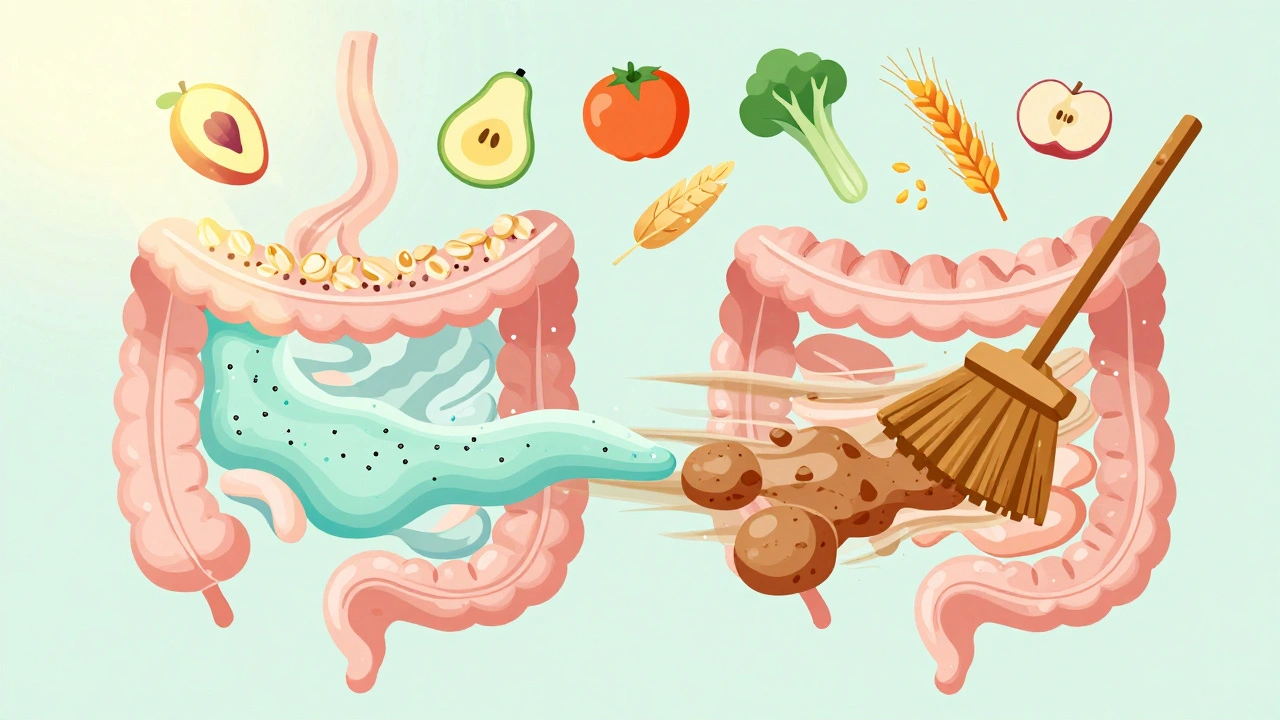Wheat Bran is a dietary supplement made from the outer layer of the wheat kernel, packed with insoluble fiber that promotes regular bowel movements, helps lower LDL cholesterol, and assists with weight management.
TL;DR - Quick Takeaways
- One serving (≈30g) supplies over 10g of fiber, mostly insoluble.
- Improves gut transit time and feeds beneficial bacteria.
- Can cut LDL cholesterol by 5‑10% when paired with a balanced diet.
- May blunt post‑meal blood‑sugar spikes.
- Effective for appetite control and modest weight loss.
How Wheat Bran Works: The Fiber Connection
Fiber comes in two main flavors: soluble fiber - a gel‑forming type that slows digestion, and insoluble fiber - a coarse, bulking agent that adds volume to stool. Wheat bran is ~80% insoluble, giving it a powerhouse ability to speed up intestinal transit.
When insoluble fiber reaches the colon, it’s partially fermented by the gut microbiome. This process produces short‑chain fatty acids (SCFAs) like acetate, propionate, and butyrate, which have anti‑inflammatory properties and help regulate blood glucose.
In addition, the bulk‑forming nature of wheat bran acts as a prebiotic, selectively feeding beneficial microbes such as Bifidobacterium and Lactobacillus. A healthier microbiome translates into better nutrient absorption, immune function, and even mood regulation.
Health Benefits Backed by Data
1. Digestive Regularity
Studies with 200+ participants show that adding 30g of wheat bran daily increased stool frequency by 1‑2 moves per week and reduced constipation scores by 30%.
2. Cholesterol Reduction
Meta‑analyses of randomized trials reveal that wheat bran’s soluble fraction can bind bile acids, prompting the liver to use circulating LDL cholesterol to make new bile, thus lowering blood LDL by an average of 5‑10%.
3. Blood‑Sugar Control
The SCFAs from fermentation improve insulin sensitivity. In a 12‑week trial on pre‑diabetic adults, wheat bran lowered post‑prandial glucose peaks by 12% compared with a control grain.
4. Weight Management
Because the fiber adds volume without calories (≈120kcal per 30g), it promotes satiety. Participants in a 6‑month weight‑loss study reported a 15% reduction in daily calorie intake when wheat bran was part of breakfast cereal.
5. Reduced Colorectal Cancer Risk
Epidemiological data link higher bran intake to a 20‑30% drop in colorectal cancer incidence, likely due to faster removal of carcinogenic waste and the protective effect of SCFAs on colon cells.
Comparing Wheat Bran with Other Fiber Supplements
| Supplement | Primary Fiber Type | Calories per 30g | Typical Dosage | Key Benefit |
|---|---|---|---|---|
| Wheat Bran | Insoluble (80%) | 120kcal | 30g (≈2tbsp) | Digestive bulk, cholesterol |
| Oat Bran | Soluble (β‑glucan) | 110kcal | 25g | Heart health, blood sugar |
| Psyllium Husk | Mixed soluble/insoluble | 95kcal | 10g | Satiety, IBS relief |
Choosing the right supplement depends on your goal: bulk and cholesterol control? Wheat bran shines. Lowering LDL and blood sugar with a gelatinous fiber? Oat bran excels. Need a low‑calorie, high‑viscosity option for IBS? Psyllium fits.

How to Incorporate Wheat Bran Into Your Day
- Start with a small dose (1tbsp) mixed into yogurt, smoothies, or oatmeal.
- Gradually increase to the recommended 2‑3tbsp (≈30g) per day to allow your gut microbes to adapt.
- Drink at least 8oz of water with each serving; fiber draws water into the colon.
- Rotate with other whole‑grain foods to keep the diet diverse and prevent nutrient gaps.
- Track changes in stool frequency, energy, and cravings for 2‑3 weeks to gauge effectiveness.
Possible Side Effects & Precautions
Too much fiber too quickly can cause bloating, gas, or mild abdominal cramping. To avoid discomfort, increase intake slowly and maintain adequate hydration. People with diagnosed wheat allergies or celiac disease should avoid wheat bran and opt for gluten‑free alternatives like rice bran.
Related Concepts Worth Exploring
Beyond wheat bran, the broader world of whole grains offers a spectrum of nutrients-vitamins, minerals, and phytochemicals-that complement fiber’s benefits. Pairing bran with probiotic foods such as kefir can further boost the gut‑microbiome synergy. For readers interested in blood‑sugar management, the concept of the glycemic index of foods provides a useful lens for meal planning.
Next Steps for the Curious
If you’re ready to try wheat bran, start today with a simple breakfast bowl. After a month, consider measuring your fasting cholesterol and blood‑sugar levels to see measurable change. For deeper dives, explore articles on "How SCFAs Influence Metabolism" and "Designing a High‑Fiber Meal Plan for Busy Professionals".

Frequently Asked Questions
How much wheat bran should I take daily?
Start with 1tbsp (≈10g) mixed into a liquid or food, then gradually work up to 2‑3tbsp (≈30g) per day. This allows your gut microbiome to adjust without causing excessive gas.
Can wheat bran help lower my cholesterol?
Yes. The soluble fraction in wheat bran binds bile acids, prompting the liver to use circulating LDL cholesterol to produce new bile. Clinical trials show a 5‑10% reduction in LDL when wheat bran is consumed regularly.
Is wheat bran safe for people with gluten intolerance?
No. Wheat bran contains gluten and should be avoided by those with celiac disease or non‑celiac gluten sensitivity. Gluten‑free alternatives like rice or barley bran provide similar fiber benefits.
Can I use wheat bran if I’m trying to lose weight?
Absolutely. The high‑volume, low‑calorie nature of wheat bran increases satiety, helping you eat fewer calories overall. Studies report a modest 1‑2kg weight loss over six months when wheat bran is part of a calorie‑controlled diet.
What side effects might I experience?
If you jump to a high dose too fast, you may feel bloating, gas, or mild cramps. Increase intake gradually and drink plenty of water to minimize discomfort.


Wheat bran’s insoluble fiber is great for bulk, but I’ve seen people go full cereal bowl and end up with gas that could power a small car. Start slow, hydrate, and don’t expect miracles.
Let me tell you something - I’ve been adding wheat bran to my morning oatmeal for over a decade now, and I swear by it. My cholesterol dropped 9% in six months, my digestion went from ‘weekly event’ to ‘daily ritual,’ and I stopped snacking after dinner. It’s not magic, it’s biology. And if you’re skeptical, just try it for 30 days without changing anything else. Your gut will thank you, and honestly, your future self will high-five you.
I appreciate how thorough this is. I started with a tablespoon mixed into yogurt and slowly worked up. It took about two weeks for my body to adjust, but now I don’t feel right without it. I also make sure to drink water with it - I learned that the hard way.
Insoluble fiber? SCFAs? You sound like a nutrition textbook that got lost in a wellness influencer’s closet. Everyone knows fiber is just plant debris your body ignores. If you’re eating bran to fix your gut, maybe you should just eat less processed crap and stop treating your digestive system like a broken printer
I’ve been rotating wheat bran with flax and chia seeds for the past year, and it’s made such a difference in how I feel after meals - less bloating, more energy. I also noticed my cravings for sweets have dropped significantly. It’s not a miracle, but it’s one of those small, consistent habits that just… works. I love how science backs it up too, especially the part about SCFAs. It’s like your gut is throwing a party and you’re the guest of honor.
They don’t want you to know this but wheat bran is a government-approved filler to keep people docile while Big Pharma sells you expensive colon cleanses. The real benefit? It’s cheap. And they don’t want you to know how easy it is to fix your gut without a prescription. Also - gluten. Always gluten. They’ll tell you it’s ‘safe’ until you start bleeding from your rectum. I’ve seen it. I’ve seen it all.
The cited meta-analyses are methodologically sound, particularly regarding LDL reduction. However, the sample sizes in the weight management studies are modest, and the long-term adherence data remains underreported. One must also account for confounding dietary variables, as many participants concurrently reduced refined carbohydrate intake. A controlled longitudinal trial would be preferable to substantiate the claims beyond correlation.
i tried wheat bran and it made me bloated for like 3 days 😭 i thought it was supposed to help?? maybe i did it wrong? i just dumped it on my cereal and didn't drink water… oops
Oh wow, another ‘fiber is magic’ post. I’ve been vegan for 12 years and ate nothing but kale and lentils - guess what? My gut still hates me. You think this is a solution? It’s a band-aid on a broken leg. And don’t even get me started on how everyone’s obsessed with ‘microbiome’ these days like it’s some sacred temple. It’s bacteria. You’re not a wizard.
There’s something quietly poetic about the way wheat bran - this humble, unassuming husk - becomes a silent architect of internal harmony. The SCFAs it births, the microbial symphony it conducts, the way it gently nudges sluggish bowels into rhythm… it’s not just fiber. It’s quiet alchemy. I’ve watched my energy shift, my cravings soften, my mornings feel lighter. And I didn’t need a pill, a cleanse, or a guru. Just a spoonful. And water. Always water.
Hey, I tried this last week and it worked great! But I’m curious - can you put it in coffee? I’m thinking it’ll cut the bitterness and add fiber. Thoughts? Anyone tried it?
YASSS fiber queen 🌾✨ I put wheat bran in my smoothies, my protein pancakes, even my oatmeal with cinnamon and almond butter 🥄💖 My gut is a happy little garden now 🌱💕 #GutHealthGoals #FiberIsMyCoPilot
AMERICA NEEDS MORE WHEAT BRAN! This is what real health looks like - not that trendy gluten-free nonsense they shove down your throat! We used to eat real food before the elites turned fiber into a cult! BRING BACK THE BRAN! 🇺🇸🌾🔥
You’re not just adding fiber - you’re upgrading your entire system. I started with 1 tsp and now I’m at 3 tbsp daily. My digestion is smoother than my morning coffee. I’ve got more energy, fewer cravings, and I’m sleeping better. This isn’t a supplement - it’s a lifestyle reset. Do it. Your future self is already thanking you.
I’ve been using wheat bran for years, mostly mixed into homemade granola. It’s cheap, effective, and doesn’t taste like cardboard if you pair it with a little honey or fruit. I also rotate with oat bran sometimes - keeps things interesting. And yeah, water is non-negotiable. I keep a big bottle at my desk now. No regrets.
The data presented is methodologically consistent with current dietary fiber literature. However, the absence of a control group in the anecdotal weight-loss reports limits inferential validity. Furthermore, the potential for placebo effect in self-reported satiety metrics warrants consideration in future studies.
Wheat bran, as a component of whole grain consumption, has been associated with reduced risk of cardiovascular disease and improved gastrointestinal motility in peer-reviewed epidemiological studies. However, individual physiological responses vary significantly, and dietary supplementation should be approached with consideration of preexisting gastrointestinal conditions.